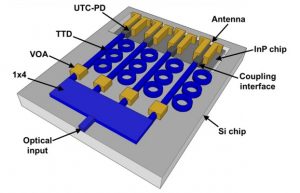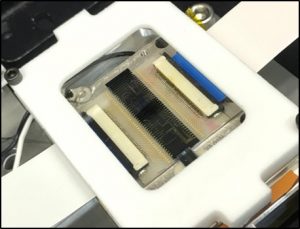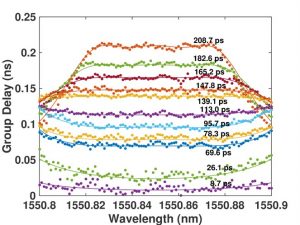Microwave photonics is the interplay between RF engineering and optoelectronics. In addition to high-performance active photonic devices (ex. lasers, photodetectors, modulators), we are developing novel integrated true time delay technologies based on ultra-low-loss waveguides for optical beam forming networks, and novel techniques to characterize group delay of resonator-based delays. Integrated microwave photonic technologies can enable analog optical fiber links, analog optical signal processing of microwave signals, photonic generation of millimeter wave and terahertz signals, arbitrary waveform generation, and photonics-enabled phased arrays. Applications include antenna remoting, sensing, space communications, and cellular (5G) networks.



Selected Relevant Publications:
- “Millimeter-Wave Photonics for Communications and Phased Arrays,” Fiber and Integrated Optics, vol. 34, no. 4, 2015.
- “RF Engineering Meets Optoelectronics: Progress in Integrated Microwave Photonics,” IEEE Microwave Magazine, vol. 16, no. 8, 2015.
- “Tuning Optimization of Ring Resonator Delays for Integrated Optical Beam Forming Networks,” Journal of Lightwave Technology, vol. 35, no. 22, pp. 4954-4960, 2017.
- “Ring resonator based integrated optical beam forming network with true time delay for mmW communications,” IEEE MTT-S International Microwave Symposium (IMS), 2017.
- “Ring Resonator True Time Delay Arrays with Sharing Optimization for Wideband Applications,” Integrated Photonics Research, Silicon and Nanophotonics Conference (IPR), paper IW2A.2, 2017.
- “Single ring resonator delays for integrated optical beam forming networks,” IEEE International Topical Meeting on Microwave Photonics (MWP), 2016.
- “Ring Resonator Delay Elements for Integrated Optical Beamforming Networks: Group Delay Ripple Analysis,” Integrated Photonics Research, Silicon and Nanophotonics Conference (IPR), paper IW1B.3, 2016.
- “A Beam-Forming Network for 5G Systems Based on Precise Optical Clock and Phase Shifting,” Conference on Optical Network Design and Modeling (ONDM), 2016.
Collaborators: Johns Hopkins University Applied Physics Laboratory, NASA, National Inter-University Consortium for Telecommunications (CNIT)